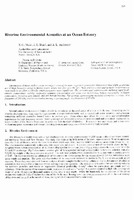Riverine environmental acoustics at an ocean estuary
| dc.contributor.author | Muir, Tom G. | |
| dc.contributor.author | Blue, J. E. | |
| dc.contributor.author | Anderson, A. L. | |
| dc.date.accessioned | 2018-10-11T14:08:19Z | |
| dc.date.available | 2018-10-11T14:08:19Z | |
| dc.date.issued | 1997 | |
| dc.identifier | 11492 | |
| dc.identifier.govdoc | CP-45 | |
| dc.identifier.uri | http://hdl.handle.net/20.500.12489/450 | |
| dc.description.abstract | The purpose of these studies was to investigate some of the more important geoacoustrc parameters that might govern the use of high frequency sonar in muddy rivers, where they flow into the sea. Both environmental and acoustic measurements were made in an effort to identify which parameters were significant. The environmental measurements included water level, current, temperature, salinity, suspended sediment concentration and grarn size distribution, bottom topography, sediment composition, including gas content, and sub-bottom layering. The acoustlc measurements included absorption vs range, at a frequency of 200 kHz, and bottom backscattering vs grazing angle, at a frequency of 85 kHz. | |
| dc.format | 6 p. : ill. ; digital, PDF file | |
| dc.language | English | |
| dc.publisher | NATO. SACLANTCEN | |
| dc.source | In: High Frequency Seafloor Acoustics (SACLANTCEN Conference Proceedings CP-45), 1997, pp. 395-400 | |
| dc.subject | Geoacoustics | |
| dc.subject | High Frequency Acoustics | |
| dc.subject | Estuaries | |
| dc.subject | River sediments | |
| dc.subject | Seafloor sediments | |
| dc.subject | Underwater acoustics | |
| dc.title | Riverine environmental acoustics at an ocean estuary | |
| dc.type | Papers and Articles | |
| dc.type | Conference Proceedings (CP) |
